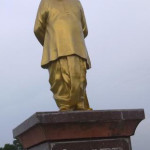Vijayawada has been declared as the capital of Andhra Pradesh. A journey from north to south of India or vice versa must transit through Vijayawada. It’s a busy transit point for rail and road journeys between north, south and east, west. The city lays 270 kms from Hyderabad, 400 kms from Chennai, 630 kms from Bengaluru and 350 kms from Vishakhapatnam and is well connected to other major cities in the country.
The choice of Vijayawada as Andhra capital is natural after the separation of Telangana, a centrally located place which combined with the twin city of Guntur is the largest urban conglomeration in the new Andhra Pradesh. Eluru, Tenali, Gudiwada, Machilipatnam are other cities and towns located within a 60-km radius of Vijayawada. The government plans to create a state capital region (SCR) around Vijayawada, on the lines of the national capital region (NCR) in Delhi.
While campaigning in Andhra Pradesh, Narendra Modi promised a city better than Delhi for the state capital. Urban Development minister Venkaiah Naidu recently announced Vijayawada as the first smart city in the country under the plan to create 100 smart cities.
Vijayawada region was always central to Andhra identity. Srikakulam, currently a village located near Vijayawada, was the ancient capital of the Andhras. The region is associated with the legend of Srikakula Andhra Mahavishnu who ruled before Satavahanas; there is an ancient Andhra Mahavishnu temple with a beautiful vigraham (murti) in the village (watch here).
Krishna Devaraya, the greatest king of Vijayanagar, known for his love of the Telugu language, visited this temple. Andhra Mahavishnu appeared in a dream and asked him to write “Amuktamalyada,” a literary composition on Andal, one of the 12 alwars, describing her pangs of separation from her beloved Lord Vishnu.
Amaravati, the imperial capital of the Satavahanas, is just 30 kms away from Vijayawada city. After Satavahanas, Vengi, capital of the Andhra Ikshvakus, Salankayanas, Vishnukundins, and Eastern Chalukyas for over seven centuries, lays 60 kms from the city. The announcement of Vijayawada as capital is thus a continuum of that ancient identity.
Vijayawada is on the banks of Krishna river; a temple for Kanaka Durga on Indrakeeladri hill on the river banks makes it a famous pilgrimage centre. There is also a church for Mary that attracts Christians from all over the state.
Before and after independence Vijayawada faced huge discrimination despite its potential for growth, from a biased caste-centric polity. It was not selected as capital in 1953, even though it was better qualified in infrastructure, resources and had popular opinion in its favour when Andhra region was separated from Madras state. The capital was eventually moved from Kurnool to Hyderabad in 1956.
Andhra University was first established in Vijayawada, but later moved to Vishakhapatnam in the 1920’s. Vijayawada paid the price for being on the wrong side of the socio-political dynamics. It was a hub of communist activity before and after independence. The first elected MP from Vijayawada was Harindranath Chattopadhyaya, brother of Sarojini Naidu, as an independent supported by the Communist Party of India. The city was also the logistical and command centre for the Telangana peasant struggle against the Nizam and a hideout for the cadre.
Political discrimination couldn’t stop the residents of the city from making their own efforts to improve infrastructure. Love for education prompted them to invite Loyola academy from Chennai to set up a college; they generously gave private land and funds for the institution. Over the years, Siddhartha Academy was established to cater for the needs of professional and technical education in the city. The Academy was first to setup a private engineering college in united Andhra. These efforts from private, non-profit groups made Vijayawada a major hub for education.
Agrarian surpluses in Vijayawada region moved into industry; Velagapudi Rama Krishna, an ICS officer, pioneered industry in the state with KCP sugar factory in 1941. Many entrepreneurs emerged from the region and were in the forefront of diversification of business in the state. They invested in transport, cinema, industry, media, agro-processing, finance, automobile workshops. Despite poor cooperation from governments, the region emerged as a major commercial centre on its own. It is a self-made city.
Entrepreneurs from Vijayawada region migrated to all major cities in the south and abroad, in search of opportunities. Those who migrated a few centuries ago pioneered industrialization in Tamil Nadu, particularly in the industrial city of Coimbatore. The unjustified target of Telangana separatism were mostly entrepreneurs from Vijayawada-Guntur region who migrated to Hyderabad to take advantage of numerous PSUs established by Central and state governments in the capital since the formation of the state in 1956. They had faced a similar fate in Madras when Andhra Pradesh was formed.
The Vijayawada entrepreneur is tired of this history repeating after investing and adapting to the region; he is treated as an outsider and his contribution denied or mocked. The residents of Vijayawada couldn’t take it anymore; they strongly felt the need for a capital in their region. The Telugu Desam Party coming to power after separation helped them as the region is well qualified and crucial for TDP fortunes.
Not only in socio-economic terms, Vijayawada is also the hub of Andhra culture. It is the birthplace of Kuchipudi dance [the village of the same name being very near to the city]. The city is home to many stalwarts in modern Telugu literature and music. The Krishna-Godavari delta is rich in Telugu culture and cuisine with strong nativity. From any perspective the region is natural choice for the capital.
The Andhra government has grand plans to develop the city on the lines of Singapore or some other grand city. Chandrababu Naidu’s obsession for Singapore is something mysterious; he is more obsessed with size than quality. If Narendra Modi’s promise to make the Andhra capital a better city than Delhi has to be realised, the focus should be more on the quality of life and facilities than the size of the city. He has a chance to model Vijayawada as a modern clean and green city with strong nativity.
An ugly metropolis doesn’t suit a culturally rich city like Vijayawada surrounded by fertile lands. The planned smart city needs to be really smart without disturbing sensitive ecology, water resources, and fertile lands in the region. A smart city with focus on green technologies, waste recycling, agro-industry, services, world class education and research institutes that promote native culture, cuisine and tourism would be ideal for Vijayawada region and would undoubtedly be better than any over burdened mega city. Andhra Pradesh needs dispersed development across regions that take advantage of local topography and benefit people, not over crowded cities.
A version of this article was originally published by Vijayvaani. The author of this post, Krishnarjun garu, can be reached on twitter and at his personal blog. We thank him for his kind permission to reprint this piece.
Disclaimer: This article represents the opinions of the Author, and should not be considered a reflection of the views of the Andhra Cultural Portal.








Enjoyed reading about Vijayawada’s significance to Andhra. Great article combining history, culture, politics, and development! 🙂